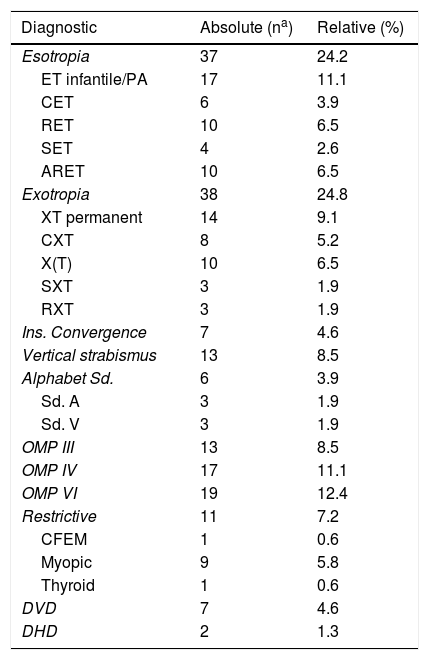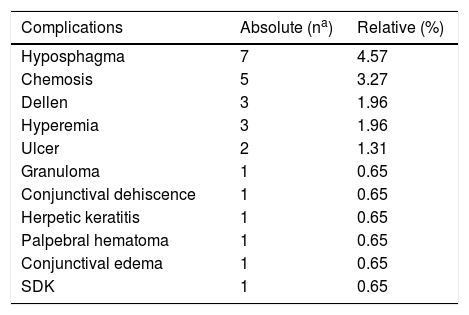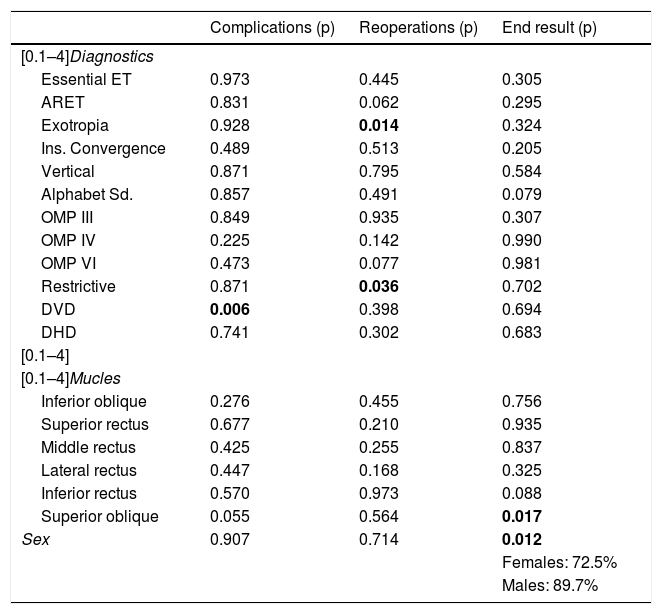to analyze the strabismus surgeries and the outcomes during a year and a half in a tertiary hospital.
Material and methodsa retrospective study of patients who underwent strabismus surgery. The mean age, sex, diagnosis, diplopia, surgery, anesthesia, adjustable sutures, results, reoperations and follow-time from surgery were analyzed. A good outcome was considered when the final horizontal deviation was less than 10 prism diopters (pd) and the vertical deviation, less than 5 pd without diplopia.
Resultsa total of 153 cases were operated on, mean age: 43.14±25.58 years (61.4%: women). The 74.5% was ≥18 years (33.33%≥ 60). The 51% had diplopia. The most frequent deviation was horizontal: 83.6%. The most frequent diagnosis was cranial nerve palsies: 32% (VI nerve: 12.4%), restrictive strabismus: 7.2%, and the aged related distance esotropia: 6.5%. Adjustable sutures were used in the 19.7% and topical anesthesia in 65.4%. The 79.2% had good outcomes at the end of follow-up. Reoperations were needed in 25.5%. Follow-up evolution time was 11.87 months ± 6.5. The sex female (P=0.012) and the oblique superior surgery (P=0.017) were associated to a bad result.
Conclusionthe adult strabismus surgery was three times more frequent than the children strabismus surgery; the third of the adults that were operated on were ≥ 60 years. The cranial nerve palsies were the most frequent diagnosis. Adjustable sutures were rarely used. The good outcomes were obtained in most of the patients at the end of follow-up.
Analizar las cirugías de estrabismo y los resultados durante un año y medio en un hospital terciario.
Material y MétodosEstudio retrospectivo de pacientes operados de estrabismo. Se analizó la edad media, sexo, diagnóstico, diplopía, técnica y anestesia, suturas ajustables, resultados, re-intervenciones y tiempo de seguimiento desde la cirugía. Se consideró buen resultado una desviación horizontal < 10 dioptrías prismáticas (dp) y vertical < 5 dp, sin diplopía.
ResultadosSe operaron 153 casos de edad media 43,14±25,58 años 61,4% mujeres. El 74,5% era≥de 18 años 33,33% ≥ de 60). El 51% tenía diplopía. La desviación más frecuente fue horizontal: 83,6%. El diagnóstico más frecuente fue la parálisis de los nervios craneales: 32% VI nervio: 12,4%, los estrabismos restrictivos representaron un 7,2% y la esotropía asociada a la edad un 6,5%. Se emplearon suturas ajustables en un 19,7% y anestesia tópica en un 65,4%. Un 79,2% obtuvo buenos resultados al final del seguimiento. Las re-intervenciones fueron el 25,5%. El tiempo medio de seguimiento: 11,87 meses ± 6,5. El sexo femenino P=0,012, y la cirugía de oblicuo superior P=0,017 se asociaron a un peor resultado.
ConclusiónLa cirugía del estrabismo del adulto fue tres veces más frecuente que la de los niños, la tercera parte de los adultos que se operaron eran≥de 60 años. Las parálisis fueron la patología más frecuente. Las suturas ajustables se emplearon en escaso número de pacientes Se obtuvieron buenos resultados en la mayoría de los casos.










